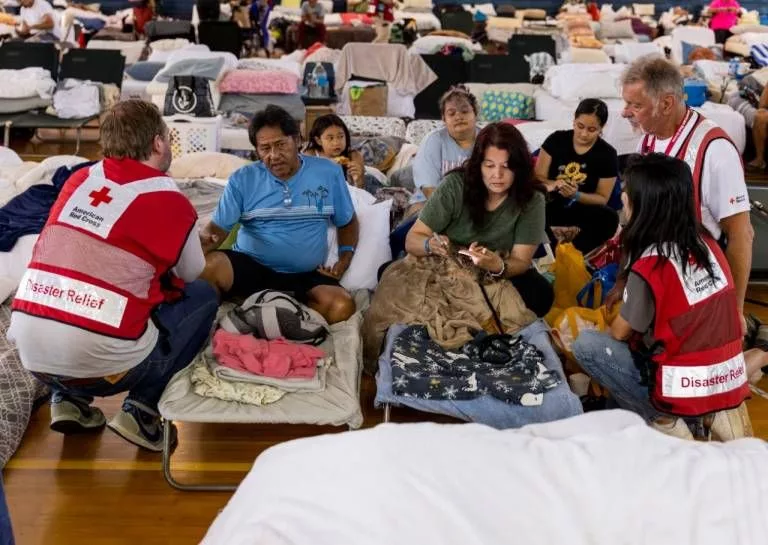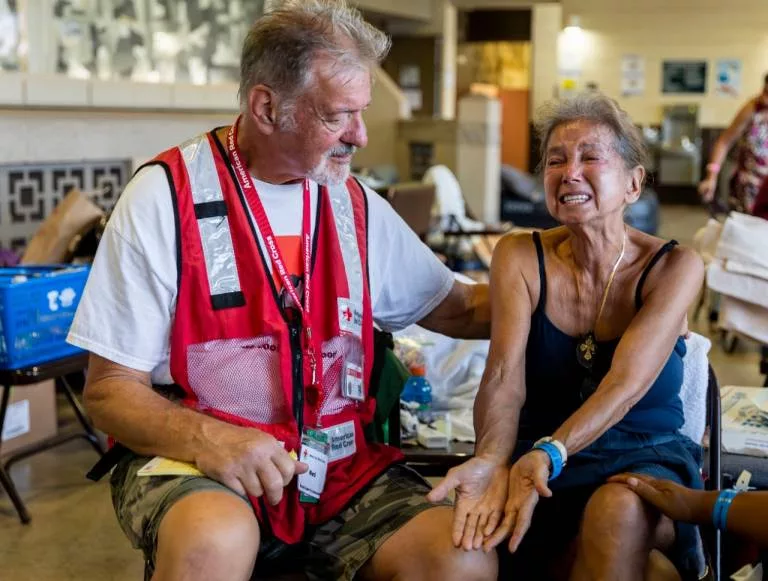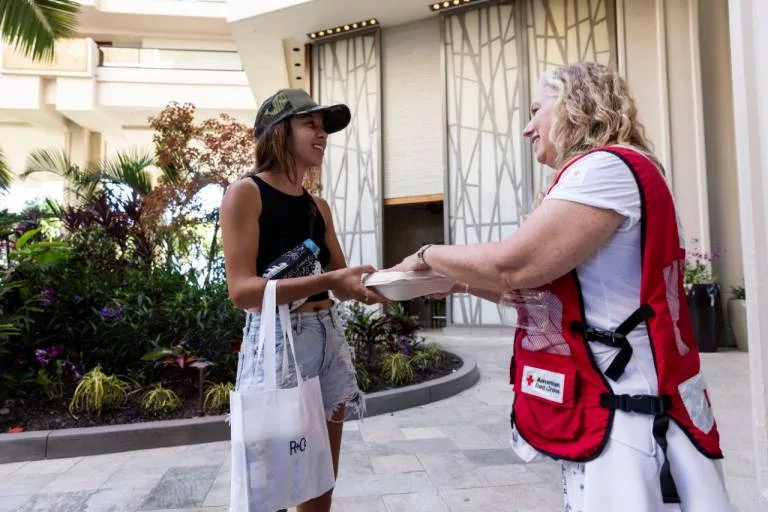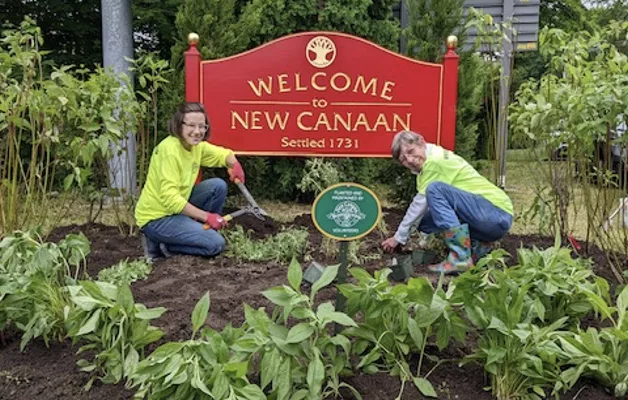
By Beth Barhydt

As dark clouds of smoke hovered over Maui, parts of the once idyllic island paradise were rendered unrecognizable by devastating wildfire – the deadliest U.S. wildfire in more than a century and in response to the current situation, the Red Cross now has two distinct missions: Mass Care Operations and Mass Fatality Operations.
In spite of this grim backdrop, the Red Cross serves as a beacon of hope, illuminating the somber narrative with tales of resilience, courage, and human spirit. The Red Cross, an organization known for its humanitarian services globally was on the ground and ready to deploy immediately. How that happened was nothing short of astonishing.
“There was an entire disaster team already on the ground, and five shelters had opened in the overnight between the 8th and 9th of August sheltering over 300 people in that overnight and ballooning to over 1,600 people by mid-day on the 9th” explains Stephanie Dunn Ashley, the CEO of the local American Red Cross, Metro New York North Chapter—a role she describes with palpable reverence. “To serve an organization that touches lives when vulnerability shadows them is a profound honor,” she notes.
In an interview early this week, Ashley described how the Red Cross team was the first on the scene to assist in the wake of the fires. The story unfolds in Guam, where Red Cross teams had been assisting in the aftermath of Typhoon Mawar for about six weeks. In the aftermath of Typhoon Mawar that severely impacted the U.S. Territories, including Guam, the Red Cross made significant relief and recovery efforts. Beginning May 18, the organization extended assistance to about 27,700 individuals, ranging from financial aid to providing nearly 30,300 overnight stays in partnership with other agencies. Moreover, almost 342,000 meals were served, and over 480 Red Cross disaster workers, 90% of whom were volunteers, ensured the distribution of emergency supplies to nearly 8,000 households.
In that moment, when time is at a standstill and shock has yet to be replaced by profound grief, the sight of the Red Cross’s emblematic crimson insignia becomes a beacon, the magnitude of which can only be truly grasped by those touched by such profound disaster.
By June 22, 2023, updates highlighted the Red Cross’s ongoing efforts in Guam, focusing on sheltering, feeding, and disaster health services. The Red Cross collaborated with entities such as the Army Corps of Engineers and FEMA (Federal Emergency Management Agency), striving to provide comprehensive recovery services, including roof installations, rental assistance, and more, for the affected residents. “Before the teams left,” Ashley added, “we trained hundreds of people on Guam on how to be responders and how to prepare for disasters.” Once completing their work in Guam, their journey across the Pacific Ocean back to the mainland U.S. brought them fortuitously close to the epicenter of the tragedy about to unfold in Maui. Some Red Cross volunteers who returned from Guam mere weeks ago quickly repacked their bags and embarked westward once again to help the response in Hawaii.
Ashley, with her dual lens of a mother and a leader, is keenly aware of the emotional landscapes as she describes people in the middle of life-altering, fast-moving, heart-rending situations. “Many people have no idea where to even start to rebuild. They have no car, no home, no clothing except what was on their back, no medications, and no means of communication. They could have their elderly parents living in a house four blocks away, also with none of that. And they have two young children.”

In that moment, when time is at a standstill and shock has yet to be replaced by profound grief, the sight of the Red Cross’s emblematic crimson insignia becomes a beacon, the magnitude of which can only be truly grasped by those touched by such profound disaster.
Maui’s devastation was unique, even for the Red Cross, which has seen countless disaster zones. With much of the island’s infrastructure decimated, including potential shelters like churches and schools, innovative solutions were paramount. “People think that we are a government organization. We are not. We are an independent nonprofit organization that is chartered by the government to respond to these kinds of disasters, but we are not the government,” Ashley clarifies, reminding us that ninety percent of the Red Cross’ workforce – including disaster responders, are Red Cross trained volunteers.
Ashley’s voice, even toned yet laden with the weight of her responsibilities, reverberates the ethos of the Red Cross. “Initially, the situation in Maui was categorized as a level three (meaning response to the disaster could cost as much as $250,000),” Ashley shared, “yet, within just two days, it escalated to a level seven.” This shift means the organization now projects spending between $10 to $20 million over the coming six or more months to help address the crisis, recovery, and rebuilding of people’s lives.
This enormous sum encompasses a myriad of vital services: shelter provision, food, vital resources, medications, mental health workers, health services, spiritual care services, reunification services, Informational services, and distribution of emergency supplies. The Red Cross’ commitment to the Maui community is unwavering. An astounding 300+ Red Cross disaster workers have provided over 30,700 meals and snacks to affected individuals and almost 5,000 overnight stays in 14 emergency shelters on Maui and Oahu. 6,000 residents have begun their Red Cross volunteer training since the fires began.
Ashley’s voice softens, but her resolve remains unshaken as she delves into the human side of the crisis. “Our hearts go out to those affected by this disaster. You will not see Red Cross blasting out on social media what they are doing there out of respect for those who have passed, but rather you will be seeing ways that you can help and where services are that can help those in need and searching for loved ones.”
While they might not broadcast their every move, their impact is undeniable. In a world where disasters are often measured in numbers and statistics, the Red Cross sees faces, stories, and souls. Their task is Herculean: providing food and shelter, reunifying separated families, offering mental health and grief counseling services, offering respect and care, and so much more.
It underscores the profound commitment humanitarian organizations maintain even when the spotlight is not directly on them.
Notably, Ashley highlighted an often-overlooked aspect of their efforts. “Beyond aiding the survivors, we also support those grieving the loss of loved ones,” she said, adding that the Red Cross assists with burial costs, scaled by the number of family members lost.
And now as families contemplate a school season overshadowed by the wildfires, the Red Cross steps in again. “We act as that moderator, mediator in between,” Ashley explains. They guide families through the maze of recovery, from navigating housing authorities to simply knowing where to start when you have lost everything.
 Yet, despite the magnitude of their operations, the organization’s outreach strategy remains subdued. “In situations of pronounced grief, we tend to be more discreet in our communications out of respect,” Ashley clarifies, responding to remarks that some observers were not even aware of the Red Cross’s presence in Maui. “While we do provide updates on our website, in crisis regions, our emphasis isn’t on broadcasting our role but on the act of helping.”
Yet, despite the magnitude of their operations, the organization’s outreach strategy remains subdued. “In situations of pronounced grief, we tend to be more discreet in our communications out of respect,” Ashley clarifies, responding to remarks that some observers were not even aware of the Red Cross’s presence in Maui. “While we do provide updates on our website, in crisis regions, our emphasis isn’t on broadcasting our role but on the act of helping.”
Due to this disaster’s scope, the Red Cross estimates they will need to provide mass care services for up to 8,000 survivors and to shelter up to 2,000 displaced survivors for at least the next eight months. Realistically, the people of Lahaina will need years to rebuild and recover. The Red Cross will be there with them every step of the way, from working with partners to building a deliberate and sustainable strategy for helping the people of Hawaii recover.
This disclosure offers a rare insight into the operational and financial magnitude of the Red Cross’s efforts. It underscores the profound commitment humanitarian organizations maintain even when the spotlight is not directly on them. Currently, the Red Cross has volunteer responders from every region in the country, helping support the people affected by these catastrophic wildfires.
Interested in joining their mission? You can help support the Red Cross by making a financial donation, donating blood, and learning lifesaving skills to keep your home and workplace safe. To support the Red Cross in their monumental efforts, visit their website www.redcross.org or you can reach out to Stephanie Dunn Ashley’s office directly for more information at 203-869- 8444 or StephanieDunn.Ashley@RedCross.org.


